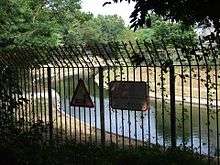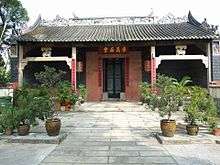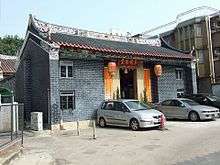Sheung Shui Wai
Sheung Shui Wai (Chinese: 上水圍), also known as Sheung Shui Heung (上水鄉) is an area in Sheung Shui, in the northern part of the New Territories of Hong Kong. Its population is around 6,000 people.[1]
Villages

Sheung Shui Heung consists of the following villages:
- Wai Loi Tsuen (圍內村). See details below
- Man Kok Village (文閣村)
- Ha Pak Tsuen (下北村)
- Sheung Pak Tsuen (上北村)
- Chung Sum Tsuen (中心村)
- Tai Yuen Tsuen (大元村)
- Hing Yan Tsuen (興仁村)
- Po Sheung Tsuen (莆上村)
- Mun Hau Tsuen (門口村)
History

The area is the core of the Liu (廖) clan, of which ancestors came originally from Fujian during the Yuan Dynasty (1271–1368). It is widely believed that the Liu clan began to settle in this part of the New Territories at the end of the 16th century.[2]
Wai Loi Tsuen is the area's original settlement,[1] with its construction completed around 1584.[3] In 1688, the size of the clan was approximately 500. As the population grew, other settlements were added: Po Sheung Tsuen, Chung Sum Tsuen and Mun Hau Tsuen were founded between 1819 and 1898. The villages are collectively named "Sheung Shui Heung".[4]
Sights
Wai Loi Tsuen

Wai Loi Tsuen is a walled village. It is the area's original settlement,[1] with its construction completed around 1584.[3] It is one of the very few rural settlements having retained its original moat.[2] The wall and the moat around Wai Loi Tsuen were constructed between 1646 and 1647.[4] The village contains a Tin Hau and a Hung Shing temples. Both have been renovated to modern structures.[5]
Liu Man Shek Tong Ancestral Hall

The Liu Man Shek Tong Ancestral Hall (廖萬石堂) in Mun Hau Tsuen was built in 1751. The three-hall two-courtyard building is the main ancestral hall of the Liu of the area. It is a declared monument[6] since January 18, 1985.[7]
Liu Ming Tak Tong Ancestral Hall
Liu Ming Tak Tong Ancestral Hall, located in Po Sheung Tsuen,[8] was first built in 1811[9] or 1828.[10] The building was demolished in 1972 and reconstructed in 1973, with only a granite door frame remaining from the original hall.[9]
Liu Ying Lung Study Hall
The Liu Ying Lung Study Hall (應龍廖公家塾), located at Po Sheung Tsuen, was built in 1838. It is a traditional two-hall study hall with an open courtyard in between.[11] It is a Grade II Historic Building.[12] A restoration project was conducted ahead of the once-in-60-year dajiao festival held in 2006.[13] The project won an Honourable Mention in the 2006 UNESCO Asia-Pacific Heritage Awards for Culture Heritage Conservation.[11][14][15]
Old Sheung Shui Police Station
The Old Sheung Shui Police Station (舊上水警署), located in Po Sheung Tsuen, was built in 1902. When the new Sheung Shui Police Station opened in 1979, the old station became a police reporting centre, and later housed a Junior Police Corps (JPC) Club House.[16] It is a Grade III historic building.[12]
References
- "At the end of the line: Sheung Shui Village - CNN Travel". Retrieved 2 March 2017.
- "Historical Background". Retrieved 2 March 2017.
- "HK Traditional Architectural Information System". Retrieved 2 March 2017.
- Liu Man Shek Tong Ancestral Hall: The establishment of Sheung Shui Heung
- "Appendix X". Retrieved 2 March 2017.
- "Liu Man Shek Tong Ancestral Hall, Sheung Shui - Declared Monuments - Antiquities and Monuments Office". Retrieved 2 March 2017.
- Environment Protection Department - List of Declared Monuments as on 1 January 1999 Archived 28 October 2009 at the Wayback Machine
- "HK Traditional Architectural Information System: Liu Ming Tak Tong Ancestral Hall. General info". Retrieved 2 March 2017.
- "HK Traditional Architectural Information System: Liu Ming Tak Tong Ancestral Hall. History". Retrieved 2 March 2017.
- Liu Man Shek Tong Ancestral Hall (part 2/4)
- "Liu Ying Lung Study Hall restoration project wins UNESCO Heritage Award (with photos)". Retrieved 2 March 2017.
- List of Graded Historic Buildings in Hong Kong (as at 6 November 2009) Archived 9 July 2011 at the Wayback Machine
- "Brief Information on Proposed Grade I Items. Item #169" (PDF). Retrieved 2 March 2017.
- The Standard: "UN honors Liu clan for saving hall", December 05, 2006
- 2006 UNESCO Asia-Pacific Heritage Award Winners
- Brief Information on Proposed Grade II Items. Item #424
External links
| Wikimedia Commons has media related to Sheung Shui Wai. |
- Delineation of area of existing village Sheung Shui Heung (Sheung Shui) for election of resident representative (2019 to 2022)
- Location map of Sheung Shui and Sheung Shui Wai (see C9)
- Liu Man Shek Tong Ancestral Hall (4 parts):
- Antiquities and Monuments Office. Hong Kong Traditional Chinese Architectural Information System. Chung Sum Tsuen
- Antiquities and Monuments Office. Hong Kong Traditional Chinese Architectural Information System. Ha Pak Tsuen
- Antiquities and Monuments Office. Hong Kong Traditional Chinese Architectural Information System. Hing Yan Tsuen
- Antiquities and Monuments Office. Hong Kong Traditional Chinese Architectural Information System. Mun Hau Tsuen
- Antiquities and Monuments Office. Hong Kong Traditional Chinese Architectural Information System. Po Sheung Tsuen
- Antiquities and Monuments Office. Hong Kong Traditional Chinese Architectural Information System. Sheung Pak Tsuen
- Antiquities and Monuments Office. Hong Kong Traditional Chinese Architectural Information System. Tai Yuen Tsuen
- Antiquities and Monuments Office. Hong Kong Traditional Chinese Architectural Information System. Wai Loi Tsuen
- Map of Wai Loi Tsuen